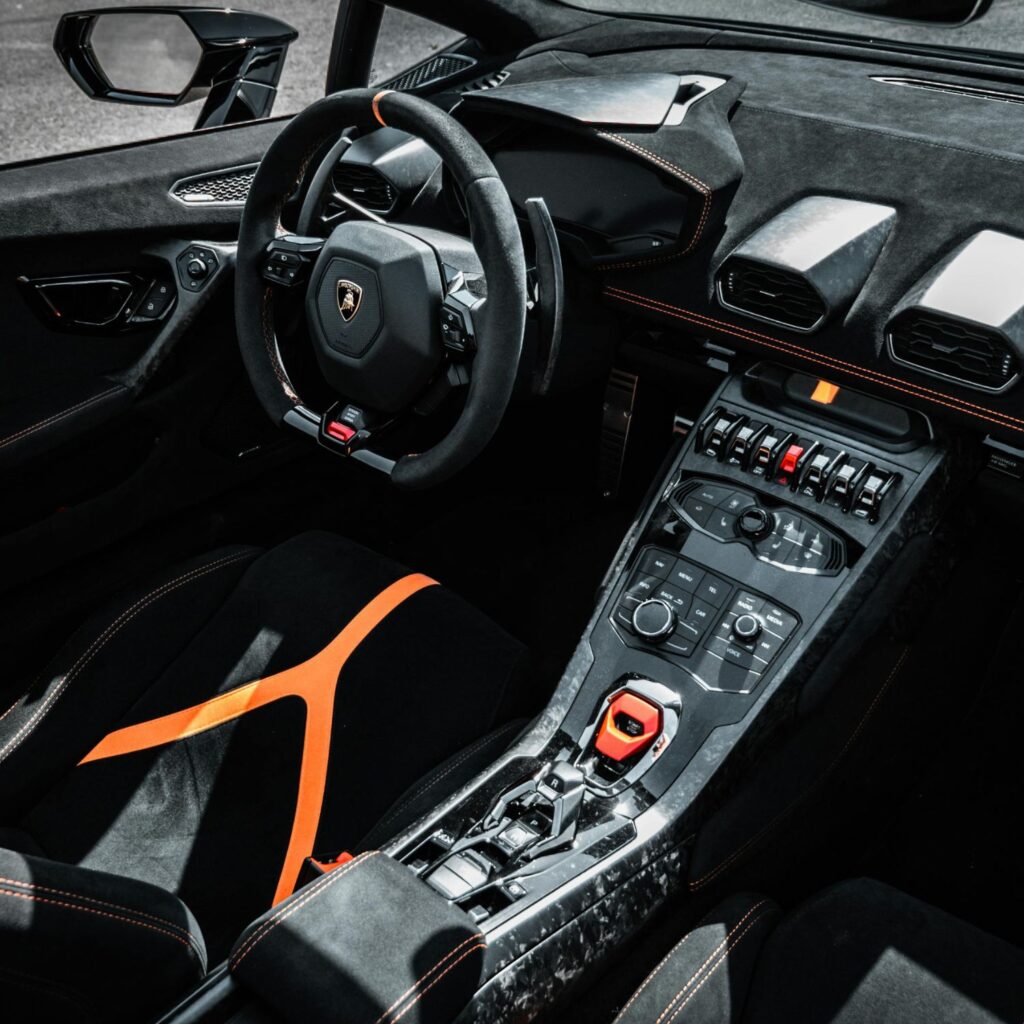Phone:
(701)814-6992
Physical address:
6296 Donnelly Plaza
Ratkeville, Bahamas.



The heart of any Lamborghini is its performance, and the E-Gear transmission was the revolutionary system that brought Formula 1-style shifting to the road. This automated manual transmission (AMT) eliminated the clutch pedal, allowing drivers to execute lightning-fast gear changes with just a flick of the steering-wheel paddles. It was a defining feature for an entire generation of supercars, blending the visceral control of a manual with the convenience of an automatic. However, this complex electro-hydraulic system is also the source of some of the most common and costly issues owners face.
The E-Gear is not a traditional automatic or modern dual-clutch transmission. It is a single-clutch manual gearbox where a sophisticated computer and a hydraulic actuator manage the clutch and gear selection. When you pull a paddle, an electric pump builds hydraulic pressure, which then activates the actuator to disengage the clutch, select the new gear, and re-engage the clutch—all in a fraction of a second.
This transmission was the flagship offering for models produced between 2003 and 2011. It is most famously found in the Lamborghini Gallardo (2003-2013) and the Murciélago (2001-2010). Understanding your specific model and year is crucial, as early versions had different reliability profiles than later, refined iterations.
Ignoring the early warning signs of an E-Gear problem is one of the most expensive mistakes a Lamborghini owner can make. What starts as a minor hesitation can quickly cascade into a catastrophic failure, leaving you with a six-figure car that is stranded and requires a five-figure repair. Proactive maintenance and immediate attention to issues are not just about performance; they are about preserving your investment and ensuring your safety on the road.
A faulty E-Gear system completely undermines the supercar experience. Instead of crisp, immediate shifts, you’ll experience jerky movements, power loss, and a driving feel that is more akin to a malfunctioning tractor than a precision Italian machine. The car’s acceleration, top speed, and overall drivability are severely compromised.
Imagine a scenario where your car fails to engage a gear while pulling into traffic, or worse, unexpectedly slips out of gear on a high-speed bend. These are genuine risks associated with failing E-Gear components. Ensuring the system is in top condition is a critical aspect of safe vehicle operation.
This is often the first and most common complaint from owners. The car feels lazy, pausing for a moment—or sometimes a jarringly long second—between gears. This “head-nod” effect during shifts is a clear signal that the E-Gear system is struggling.
The root causes are often linked to the hydraulic system’s inability to generate or maintain pressure. Low or degraded hydraulic fluid, a tired E-Gear pump, or a weak hydraulic accumulator are the usual suspects. Internally, a worn-out clutch pack can no longer engage smoothly, also leading to sluggish behavior.
Allowing sluggish shifting to persist places immense stress on the entire drivetrain. The clutch wears out prematurely, the gearbox synchronizers are abused, and the constant shock loading can damage the differential and even axle components. A $2,000 pump replacement can quickly turn into a $15,000 transmission overhaul.
This is a more severe and alarming problem where the transmission refuses to go into gear, gets stuck in a gear, or slips into neutral unexpectedly. This often strands the vehicle and requires a tow truck.
The most obvious sign is the gear indicator on the dashboard flashing or displaying an error message like “GEAR BOX FAILURE.” Physically, the car will not move when you select “A” (Auto) or use the paddles. Sometimes, it may engage but then immediately pop back into neutral under load.
This failure can be hydraulic or electronic. A completely failed E-Gear pump provides zero pressure for shifts. A faulty gear position sensor or reverse lockout solenoid can prevent the computer from understanding what gear to select. Internal mechanical failures, like a broken shift fork inside the gearbox, are less common but far more serious.
The hydraulic actuator is the muscle of the E-Gear system. It is responsible for the physical movement of the gear selector and the clutch engagement. When it fails, the brain (the computer) is giving commands, but the body isn’t responding.
This component converts hydraulic pressure from the pump into precise mechanical action. It contains a series of valves and pistons that first actuate the clutch release mechanism and then move the gear selector rods to choose the correct gear. It’s a high-precision part that operates thousands of times.
Symptoms often overlap with other issues but point directly to the actuator when certain patterns emerge.
The E-Gear pump is the heart of the hydraulic system. Its constant job is to create the high-pressure fluid reserve needed for gear changes. It is one of the most common failure points and a leading cause of E-Gear anxiety.
This electric pump pressurizes hydraulic fluid into an accumulator, a small tank that stores energy. When a shift is commanded, valves open, and this stored pressure is instantly released to the actuator, allowing for a fast shift without waiting for the pump to build pressure from zero each time.
The pump is an electric motor, and like all motors, it has a finite lifespan. The constant cycling on and off leads to wear on the motor’s brushes and bearings.
Lamborghinis are a complex network of sensors and wires, and the E-Gear system relies on this network to function correctly. A single faulty sensor or a chafed wire can cause a myriad of confusing and intermittent problems.
Critical sensors include the gear position sensor, clutch position sensor, and input/output speed sensors. The wiring harness that connects these to the transmission control module (TCM) is exposed to heat, vibration, and moisture, making it susceptible to damage over time.
Electrical faults are the trickiest to diagnose. They may not set a consistent fault code, and the symptoms can mimic a hydraulic or mechanical failure. It requires a technician with deep knowledge of the system and access to wiring diagrams to perform voltage drop tests and continuity checks.
Throwing parts at an E-Gear problem is a recipe for financial ruin. The first and most critical step is always a proper diagnosis using the right tools. A generic OBD-II scanner is virtually useless for this task.
Professional-grade tools like the Lamborghini OEM diagnostic system (or advanced third-party tools like Autel or Launch with specific Lamborghini software) are mandatory. They can communicate directly with the Transmission Control Module (TCM) to read proprietary fault codes and view live data streams.
A code itself is a starting point, not a verdict. For example, a “P1890 – Clutch Actuator” code doesn’t always mean the actuator is broken. An expert technician will use this code as a clue to then check the live data for clutch position, command the actuator to move, and check the hydraulic pressure during the event to determine if the issue is electrical, hydraulic, or mechanical.
Before any complex diagnostics, a thorough visual inspection can often reveal the obvious culprit. This is a low-tech but highly effective first step.
The E-Gear system uses a specific hydraulic fluid (often Pentosin CHF-11S or similar). The reservoir is typically located in the engine bay. The fluid should be checked with the system at a specific temperature and pressure, following the exact manufacturer’s procedure. Low fluid is a major red flag.
A careful look underneath the car and around the transmission can reveal tell-tale signs of trouble.
A skilled technician must experience the problem firsthand to properly diagnose it. A controlled test drive is an essential part of the process.
The technician will drive the car under various conditions to replicate the owner’s complaints. This includes light-throttle city driving, full-throttle acceleration, and aggressive downshifts.
The human ear is a powerful diagnostic tool. Different problems produce distinct acoustic signatures.
This is the most common category of E-Gear repairs. Keeping the hydraulic system in good health is paramount to the transmission’s longevity.
This is not like a simple oil change. The system must be bled of all air to function correctly, a process that requires specific commands to be run through the diagnostic computer to cycle the pump and actuators.
While actuators can sometimes be rebuilt by specialized shops, most often they are replaced with new or remanufactured units due to the precision required.
Chasing electrical gremlins requires patience and a methodical approach.
Once a faulty sensor is identified via diagnostic codes and live data, replacement is typically straightforward.
Repairing a damaged harness is preferable to replacement, which is exorbitantly expensive.
The software that controls the E-Gear is just as important as the hardware. Lamborghini released several updates over the years to improve shift smoothness and reliability.
Later software versions often featured revised shift maps and clutch engagement strategies that were less aggressive, reducing wear on the clutch and hydraulic components.
This is a dealer or specialist-level task.
When key components fail, owners are faced with important decisions regarding parts sourcing and cost management.
The choice here has significant implications for cost, reliability, and resale value.
E-Gear repairs are expensive. Having a clear budget and understanding the trade-offs is critical. The table below provides a realistic breakdown of common repair costs (Parts & Labor).
An ounce of prevention is worth a pound of cure, and this is never truer than with the E-Gear system. Adhering to a strict maintenance schedule is the single best way to avoid catastrophic failures.
Don’t wait for something to break.
This is the lifeblood of the system.
How you drive has a profound impact on how long your E-Gear system lasts. Intelligent driving can double the life of expensive components like the clutch.
The E-Gear is robust, but it’s not indestructible.
Cold components are brittle components.
The Lamborghini E-Gear is a masterpiece of engineering that delivers an exhilarating driving experience, but it comes with a known set of responsibilities. The primary adversaries are time, heat, and neglect, which manifest as hydraulic pump failures, actuator issues, and electrical gremlins.
The core of most E-Gear problems lies in the high-stress hydraulic system—the pump and actuator—which are subject to wear. Electrical sensors and wiring fail due to the harsh environment. The single-clutch design itself is inherently more prone to jerkiness and wear than a modern dual-clutch unit.
The key to affordable ownership is vigilance. Pay attention to the subtle changes: a slightly longer pump run time, a small hesitation on the 2-3 shift, or a new, faint whine. Addressing these early signs can prevent a minor issue from becoming a financial catastrophe.
While the DIY spirit is admirable, the E-Gear system is not the place for amateur experimentation. The complexity, cost of parts, and need for specialized tools make professional intervention not just a recommendation, but a necessity.
A qualified Lamborghini specialist possesses the knowledge, software, and experience to accurately diagnose the root cause of a problem, saving you from the costly cycle of replacing parts blindly. They can also provide invaluable advice on preventative measures specific to your driving habits and climate.
Entrusting your car to a professional ensures that repairs are done correctly with the right parts and procedures. This protects the performance, reliability, and resale value of your Italian supercar, allowing you to enjoy its breathtaking capabilities for years to come.
The absolute maximum interval is 15,000 miles or three years. However, for owners who track their car or drive in very hot climates, an annual fluid change is a wise and relatively inexpensive insurance policy. The moment you notice a slight degradation in shift quality, a fluid change should be your first action.
No, you cannot entirely prevent wear and tear on a complex mechanical system. However, you can drastically reduce the likelihood of major, strand-you-on-the-side-of-the-road failures. A rigorous regimen of preventative maintenance and gentle driving habits will manage the inherent weaknesses of the system and provide a largely trouble-free ownership experience.
Costs are highly variable, but you must be prepared for four-figure repairs as a standard. A simple fluid service starts around $800. A new E-Gear pump will cost between $3,500 and $6,500 installed. The most common major repair, a clutch replacement, almost always includes a new flywheel and will run between $6,000 and $11,000. The golden rule is: diagnose thoroughly to avoid misdiagnosis and unnecessary costs.
For the vast majority of owners, no, it is not advisable. While it eliminates the E-Gear’s hydraulic and electronic complexities, it introduces others. The conversion is incredibly involved, requiring custom fabrication, and can cost well over $25,000. It will also significantly impact the car’s resale value, as purists generally seek out original, factory-spec cars. It should only be considered by an enthusiast who has a dedicated track car and has a deep-seated preference for a manual, regardless of cost or value impact.
Yes, but they must be chosen carefully. The most popular and reliable upgrade is a revised, heavy-duty E-Gear pump from a reputable manufacturer, which is designed to be more robust than the original. There are also aftermarket clutch kits that offer better longevity and smoother engagement. Crucially, any hardware upgrade should be paired with the latest official Lamborghini software calibration for optimal results. Avoid cheap, no-name parts from unknown sources.